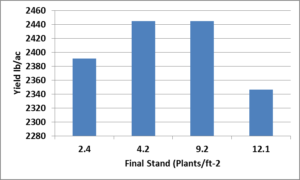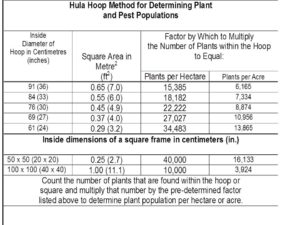Maximizing the potential yield of your canola begins with proper stand establishment. So 14-30 days after seeding your canola is a good time to go and assess your canola stands and the job of seeding. This will not only help to observe any problems, but give you some feedback on drill performance and what changes you might make for next year.
So What is an Optimum Stand ?
A final canola stand of 7-12 plants/ft2 is considered optimum for full yield potential. This will allow for seedling mortality due to disease, insect feeding, weed or plant to plant competition, weather factors. At plant stands below 3-4 plants/ft2 ,potential yield can be reduced. Trials conducted by Dr Hugh Earl, University of Guelph confirm that yield is not reduced until final stand is reduced below 4 plants/ft2 (Figure 1). At low plant populations canola plants branch more extensively, have larger stalks, but mature 3-4 days later. At high populations, plants will flower and mature more uniformly due to less branching, and have thinner stalks which can increase lodging. In the research trials, yield was reduced at the highest seeding rate due to lodging. In On-farm seeding rate trials conducted in 2010, yields were equal at seeding rates between 3,5, 5, and 7 lbs/ac, however at the 7 lb/ac rate lodging was evident in all trials.
Figure 1: Effect of Canola population on Yield

Effect of Canola Final Plant Stand on Yield (initial Seeding rate: 1.5,2.9,5.7,8.6 lb/ac)
Using a Hula Hoop to Assess Plant Populations
To determine the number of plants per square foot (plants/ft2 ), using a hula hoop, count the number of plants inside the hoop. Refer to Table 1 below for various size hoops to determine the area within the hoop. If you prefer to use a meter stick, lay the stick down the row and make a mark at both ends. Then lay the stick across the rows to get a square metre. Count the number of plants inside the meter square area,divide by 10.8 to arrive at plants/ft2 .
Table 1: Hula Hoop for Determining Plant Populations

Assessing Stands
Be sure to make a number of stand counts across the field and make note of reasons for low stand counts in various areas. If you are unsure of the cause, take lots of high resolution pictures and show these to your agronomist to help determine the cause. It is a good idea to compare your final stand count to the seeding rate table to see what percent seedling survival was actually achieved. To calculate the percentage of seeds sown that emerged (ie % seedling survival), obtain the seed size from the seed bag and determine the seeds/lb from the table below. Using the formula below to calculate seedling survival.
Percent Seedling Survival= Final plant stand/Seeds per acre X 100
Final plant stand= plants/ft2 X 43,462
Example:
Final plant stand= 5 plants/ft2 , Seed size = 6 gm/1000 seeds, Seeding rate 5 lb/ac
Plants per acre= 5 plants/ft2 X 43562= 217810 plants per acre
Seeds/acre (Table 2)= 75667 seeds/lb X 5 lb/acre seeding rate= 378,335
Seedling survival %= 217810/378335 X 100= 57.6% emergence
Finally be sure to keep a note of those stand counts so you can make changes for next year. With this information you can fine tune your seeding rate, adjust seeding equipment, and perhaps not make the same mistake twice!
Table 2: Canola Seed Size and Seeding Rate

Source: Fieldcropnews